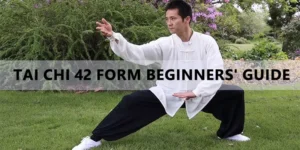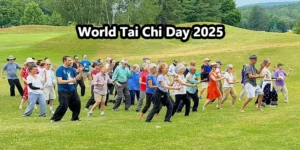Tai Chi 42 Form is popular all over the world because it perfectly mixes traditional Tai Chi styles with being practical and easy for many people to learn and enjoy. This blog will focus on the reasons why Tai Chi 42 Form is popular, its structure, its origin, movements, and advantages.
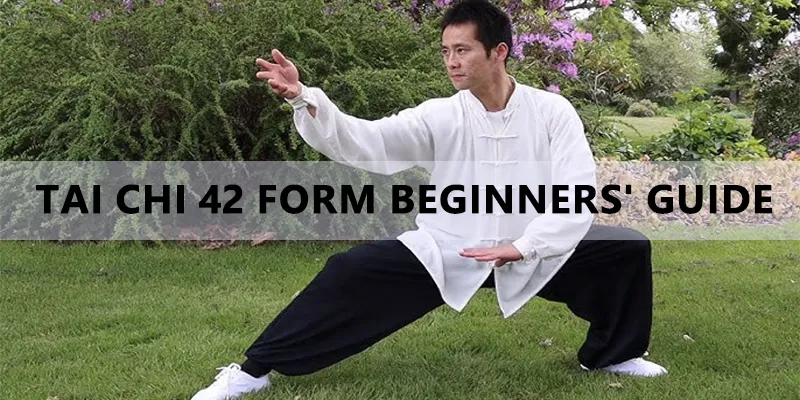
Why Is the Tai Chi 42 Form So Popular?
Tai Chi 42 Form was created in the 1980s by experts working together for China’s national sports group. This form wasn’t made up from scratch; instead, it carefully selects and combines the very best, most important movements from the four major traditional family styles of Tai Chi—Yang, Chen, Wu, and Sun.
This means when you practice the tai chi 42 Form, you get to experience the smooth, flowing grace of Yang style, the powerful bursts of energy and softer moments of Chen style, the compact, precise steps of Wu style, and the lively, higher stances and footwork of Sun style, all in one complete set.
Another huge reason for its popularity is its length and manageability; it’s much shorter than many traditional long forms that can have 80 or even 100 movements, making it much less intimidating for beginners and far easier to fit into a busy life. Learning and remembering the Tai Chi 42 forms is simply more achievable for most people starting out.
Furthermore, it was designed specifically to be a competition form, so it flows beautifully from one movement to the next and looks very nice and balanced to watch. But it’s not just about looking good; the Tai Chi 42 Form packs all the powerful health benefits Tai Chi is famous for into a shorter practice.
People love it because it genuinely helps them feel better—improving balance so they are less likely to fall, making joints more flexible and less stiff, calming the mind to reduce stress and anxiety, and gently strengthening the body. Because it’s this recognized standard form taught everywhere, from community centers and parks to hospitals and gyms, you can find classes almost anywhere in the world, and everyone is learning the same sequence. This makes it easy to join a group and practice with others.
Tai Chi 42 Form Structures
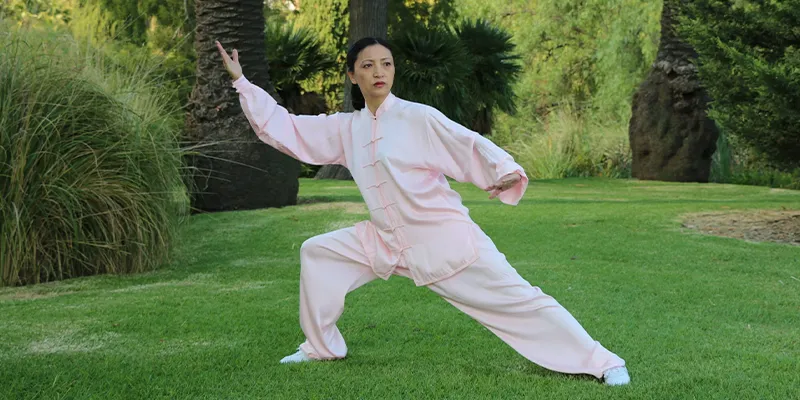
The Tai Chi 42 form is divided into four main parts. This structure helps practitioners learn and perform the sequence effectively.
The first part, covering moves 1 through 10, acts as the gentle opening and warm-up phase; it begins with slow, grounding postures like the Beginning Pose and includes fundamental Tai Chi patterns such as Grasp the Bird’s Tail and the classic Single Whip stance, all designed to calm the mind, center the body, and establish a steady breathing rhythm.
Following this, the second part (moves 11 through 20) introduces more dynamic movements and directional changes, often called the North Section; here you practice stepping firmly into stances like Step Up to Form Seven Stars, generating controlled power through actions such as Turn and Strike with Fist, and improving your coordination with graceful turns seen in moves like Jade Lady Works the Shuttles to the left and right, all while learning to shift your weight smoothly between high and low positions.
The third part, encompassing moves 21 to 34 and often referred to as the South Section, challenges your balance and control further by incorporating contrasting speeds, precise hand techniques, and controlled kicking actions; this is where you encounter moves like Wave Hands Like Clouds with its continuous circling motions, the elegant Fair Lady Works at Shuttles, and the powerful kicking sequence of the Double Wind Blows Through Ears, demanding greater stability and focus.
Finally, the fourth part (moves 35 to 42) serves as the closing, gradually returning to a state of calm; it revisits core principles through moves like another Single Whip and Grasp the Bird’s Tail, incorporates a deep, controlled squat in Cross Hands Downward Posture, and culminates in the peaceful Closing Pose, allowing your energy to settle and your breathing to return to normal, completing the entire journey of the form from stillness back to stillness.
This four-part structure ensures a balanced practice that develops strength, flexibility, coordination, and mental focus.
Tai Chi 42 Form Origin and History
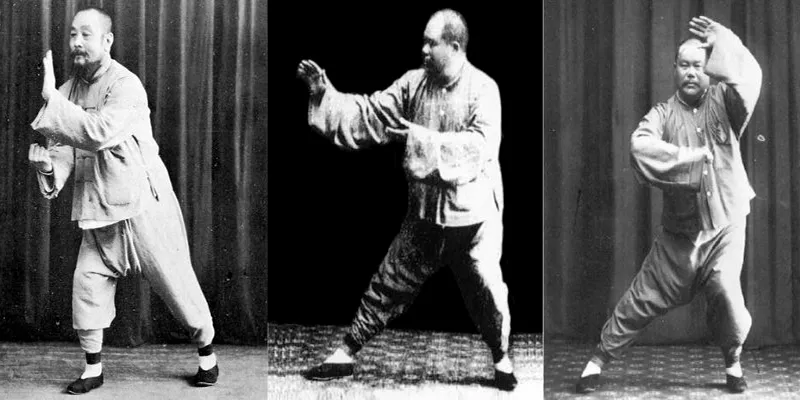
Tai Chi 42 form, officially known as the 42-Step Competition Routine, has a fascinating history compared to older Tai Chi styles.
Tai Chi 42 Form was created in 1989 by a special group of Tai Chi masters and sports experts working for the Chinese Sports Commission, which is the main organization in China responsible for promoting sports and physical activities. Their goal was to design a brand-new Tai Chi routine that could be used fairly and consistently in international competitions. Before this, people competed using many different traditional styles, which made judging difficult.
They also wanted to create a form that captured the best elements from the major Tai Chi styles—Chen, Yang, Wu, and Sun—blending their unique characteristics into one complete practice. This new form wasn’t meant to replace the ancient styles but rather to provide a standard way for people all over the world to learn, practice, and compete using a shared set of movements that represented the core principles of Tai Chi as a whole.
The tai chi experts didn’t just make up new moves; instead, they studied the most important and beautiful sequences from the Chen, Yang, Wu, and Sun styles. They selected classic postures like “Grasp the Bird’s Tail,” “Single Whip,” “Wave Hands Like Clouds,” “Jade Lady Works the Shuttles,” and “Fair Lady Works at Shuttles” because these movements perfectly show Tai Chi’s key ideas. Every transition between moves was designed to feel natural and continuous, like water flowing in a stream.
Since its official introduction in 1989, the tai chi 42 form has spread across the globe incredibly quickly. It became the required routine for Tai Chi events in major multi-sport games like the Asian Games, and it is now the standard form used in countless tournaments worldwide, from local competitions all the way up to the World Championships.
Its popularity isn’t just for athletes; because it clearly combines the essence of the four major styles in a balanced and well-structured way, it has also become one of the most popular forms for everyday learners everywhere.
Tai Chi 42 Form Motions

The Tai Chi 42 form features a sequence of 42 distinct movement names, each describing a specific posture or action drawn from centuries of Chinese martial arts tradition.
Opening Section (Moves 1–10):
The form begins with Commencement (Qǐshì), establishing calm focus, followed by Grasp the Bird’s Tail (Lǎn Què Wěi)—a four-part sequence of Ward Off (Péng), Roll Back (Lǚ), Press (Jǐ), and Push (Àn). Next comes Single Whip (Dān Biān), where the body opens like a turning door, then Lift Hands (Tí Shǒu) and Shoulder Strike (Kào). White Crane Spreads Wings (Bái Hè Liàng Chì) balances softly on one leg, leading into Brush Knee and Step Forward (Lǒu Xī Ào Bù) performed left and right, and concluding with Hands Playing the Lute (Shǒu Huī Pí Pá).
North Section (Moves 11–20):
This phase builds energy with Step Up to Form Seven Stars (Shàng Bù Qī Xīng), Step Back to Ride the Tiger (Tuì Bù Kuà Hǔ), and Turn and Strike with Fist (Zhuǎn Shēn Bān Lán Chuí). Deflect Downward, Parry, and Punch (Zuǒ Lǚ Nī Zhòu Chuí) combines defense and attack, while Embrace Tiger and Return to Mountain (Bào Hǔ Guī Shān) shifts direction powerfully. Fist Under Elbow (Zhǒu Dǐ Kàn Chuí) and Step Back to Repulse Monkey (Dǎo Juàn Gōng)—executed twice—refine coordination, ending with Wild Horse Parts Its Mane (Yě Mǎ Fēn Zōng) to both sides.
South Section (Moves 21–34):
Here, movements expand in range: Cloud Hands (Yún Shǒu) flows like drifting clouds, High Pat on Horse (Gāo Tàn Mǎ) extends the arms gracefully, and Right Separation Kick (Yòu Dēng Jiǎo) balances on one leg. Double Wind Blows Through Ears (Shuāng Fēng Guàn Ěr) strikes symmetrically, Turn Body and Left Heel Kick (Zhuǎn Shēn Zuǒ Dēng Jiǎo) pivots sharply, and Snake Creeps Down (Shé Shēn Xià Shì) lowers the body deeply. Golden Rooster Stands on One Leg (Jīn Jī Dú Lì) tests balance, Fair Lady Works at Shuttles (Yù Nǚ Chuān Suō) angles diagonally, and Turn Body with Lotus Kick (Zhuǎn Shēn Bǎi Lián) whirls gracefully before Bend Bow to Shoot Tiger (Wān Gōng Shè Hǔ) channels focused power.
Closing Section (Moves 35–42):
The form gently returns to stillness: Oblique Posture (Xié Fēi Shì) flows into Step Forward, Parry, and Punch (Jìn Bù Bān Lán Chuí) and Guard with Closed Fist (Rú Fēng Shì Bì). Cross Hands Downward Posture (Shízìshǒu) sinks into a deep squat, followed by final echoes of Grasp the Bird’s Tail and Single Whip. Swinging Hands (Yáo Huā Chuí) releases tension, culminating in Closing Form (Shōushì)—hands lowering softly to complete the cycle.
Tai Chi 42 Form Advantages
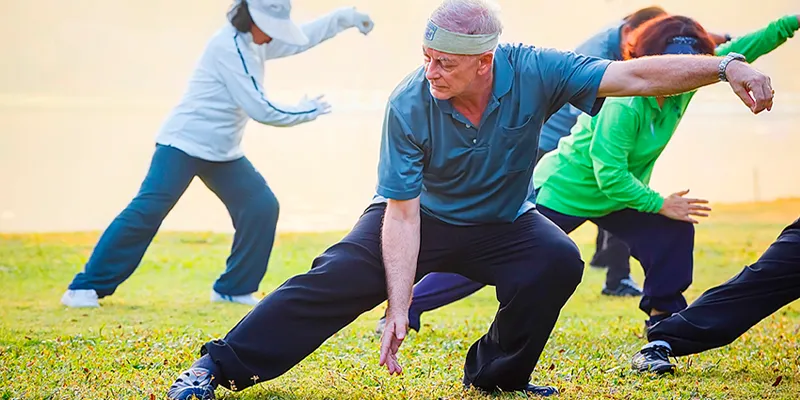
Body Stronger and More Flexible
The tai chi 42 form involves gentle, flowing movements that use almost every muscle and joint in your body. You move your arms, legs, and torso slowly but steadily in different directions, reaching, turning, stepping, and shifting your weight. This constant, controlled motion is like giving your muscles a good, safe stretch. It helps make your arms and legs stronger, improves your posture (how you stand and sit), and makes your joints, like your knees, hips, and shoulders, move more easily and feel less stiff. It keeps your body feeling loose and capable.
Keeps Balance and Prevents Falls
A huge benefit of Tai Chi 42 form is how much it improves your balance. Many of the movements require you to stand on one leg while slowly and carefully moving the other leg or to shift your weight very smoothly from one foot to the other. You learn to feel exactly where your body is in space and how to control your movements precisely. Practicing this regularly strengthens the muscles in your legs and ankles that keep you steady. This makes you much less likely to trip or fall, which is especially important as people get older. It trains your body to stay stable.
Exercise Heart and Lungs
Even though it looks slow, the Tai Chi 42 form gives your heart and lungs a good workout. The continuous, smooth movements keep your body active for the entire practice session. Your heart beats a little faster, you breathe deeper, and your blood flows better all over your body. The best part is that it does this without making you feel out of breath or sweaty or putting stress on your joints like running might. It’s a gentle way to keep your heart healthy and your energy levels up. You won’t get super sweaty, but you will feel invigorated.
Calms Mind and Reduces Stress
Practicing the tai chi 42 form requires you to focus your attention. You need to concentrate on your breathing, remember the sequence of movements, and pay attention to how your body feels as you move. Worries and rushing thoughts tend to fade away while you practice. The slow, rhythmic movements and deep breathing naturally help your body relax. This makes Tai Chi a powerful tool for reducing everyday stress, feeling less anxious, and improving your overall mood. It’s like a moving meditation.
Sharpens Mind and Memory
Learning and remembering the Tai Chi 42 forms in the sequence is a fantastic workout for your brain! You have to memorize the order of the movements, how your arms and legs coordinate, where your weight should be, and how to transition smoothly from one move to the next. This constant mental practice improves your concentration, boosts your memory skills, and enhances your coordination—making your brain and body work together better. It keeps your mind active and engaged.

